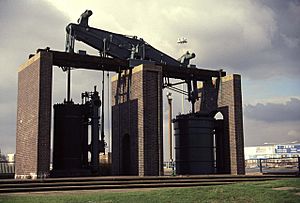Grazebrook beam engine facts for kids
The Grazebrook Engine is a very old and powerful machine. It is a type of steam engine called a beam engine. This engine was built in 1817. Its main job was to blow air into a blast furnace. This made the fire much hotter for making iron.
Today, you can see this huge engine in Birmingham, England. It stands proudly on the Dartmouth Circus roundabout. This is near the entrance of the A38(M). Many people believe it is the biggest steam engine ever used in Birmingham.
History of the Grazebrook Engine
This amazing engine was built in 1817. It was designed by the famous engineer James Watt. His company, Boulton & Watt, had a factory in Soho, Birmingham. The engine was built by a company called Grazebrook & Whitehouse.
They built it for their ironworks in Dudley. The engine's job was to provide air for two large blast furnaces. These furnaces were used to make iron. The engine worked hard for many years.
In 1912, the engine was finally retired. It stayed on site as a backup, just in case it was needed. Then, in 1964, it was taken apart. Now, it is on display at the Dartmouth Circus roundabout. This is a busy spot where the A38(M) (Aston Expressway) meets the A4540 (Dartmouth Middleway).
How the Engine Works
The Grazebrook Engine is a great example of early 19th-century engineering. It has a tall, vertical steam cylinder. This cylinder is connected to a large, rocking beam. The beam is about 8 metres (26 ft) long. It helps to move a second cylinder, which is an air cylinder.
The rocking beam is made of heavy cast iron. It is 28 feet (8.5 m) long and weighs about 10 long tons (10 t). The steam cylinder is 42 inches (1,100 mm) wide. It has a stroke of 8 feet (2.4 m). This means it moved up and down by that much.
The engine was designed to run at 12 to 16 strokes per minute. Steam to power it came from six large Lancashire boilers. A special pressure tank helped to keep the air flowing smoothly. The engine blew air at 5 pounds per square inch (34 kPa) into the two blast furnaces.
The building where the engine was housed was special too. It was built with lime mortar. This allowed the building to "flex" or move slightly with the engine. This helped to protect the structure from the engine's powerful movements.
The Grazebrook Company
The company that built the engine, M. & W. Grazebrook, has a very long history. It can be traced back to 1641. That's when Michael Grazebrook started his business in Stourbridge.
Over the years, the company had different types of businesses. They had a glassworks in Stourbridge. They also had a forge in Halesowen in the 1700s. They even owned their own coal mine in Coseley.
Later, the company focused on making iron. They moved their main operations to Netherton in 1800. Their factory was even connected to the Dudley Canal. This helped them transport their goods easily.


